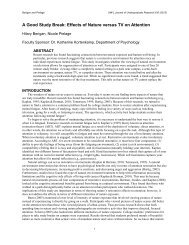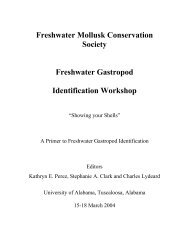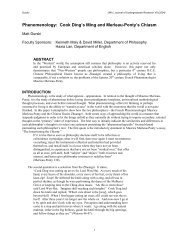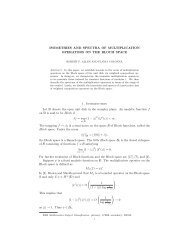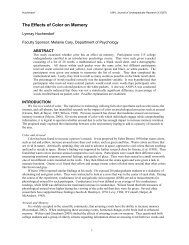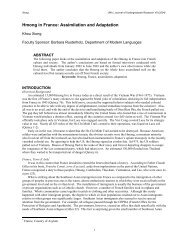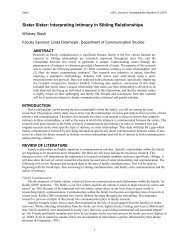A Guide for Terrestrial Gastropod Identification - University of ...
A Guide for Terrestrial Gastropod Identification - University of ...
A Guide for Terrestrial Gastropod Identification - University of ...
You also want an ePaper? Increase the reach of your titles
YUMPU automatically turns print PDFs into web optimized ePapers that Google loves.
Sagdidae<br />
Jochen Gerber, Field Museum <strong>of</strong> Natural History<br />
This family is distributed in Central America and the West Indies. A single species,<br />
Lacteoluna selenina, is found in North America (S. Florida). It has a small (ca. 5 mm),<br />
depressed, umbilicate, dull-white shell. The whorls are “shouldered”. The outer lip <strong>of</strong> the<br />
aperture remaines straight and thin even in fully grown specimens.<br />
They live in areas with some tree or shrub cover under rocks and plant debris.<br />
TAXON AUTHOR<br />
G-<br />
RANK DISTRIBUTION<br />
Lacteoluna selenina (Gould, 1848) G2 FL<br />
Spiraxidae<br />
Kathryn E. Perez, Duke <strong>University</strong><br />
There are only 4 species <strong>of</strong> the carnivorous snails in this family in the U.S. and Canada,<br />
but several hundred species <strong>of</strong> several genera in Mexico, the Caribbean, Central and South<br />
America. Euglandina rosea is a large (up to 76 mm length, up to 30 mm width), common snail<br />
<strong>of</strong> the southeastern US and has been introduced to many places worldwide, <strong>of</strong>ten intentionally,<br />
into CA as well as numerous Pacific Islands. The introductions <strong>of</strong> E. rosea rate as one <strong>of</strong> the<br />
worst described cases <strong>of</strong> a failed attempt at biological pest control resulting in heavy predation<br />
pressure on native land snails <strong>of</strong> those areas (Cowie, 2001; Lydeard, et al. 2004). In Florida they<br />
can be found <strong>for</strong>aging <strong>for</strong> terrestrial snails on the ground, or in wet weather, climbing on the<br />
stems and leaves <strong>of</strong> small trees, ~1 m <strong>of</strong>f the ground (Davis, Perez & Bennett, 2004). This<br />
53






